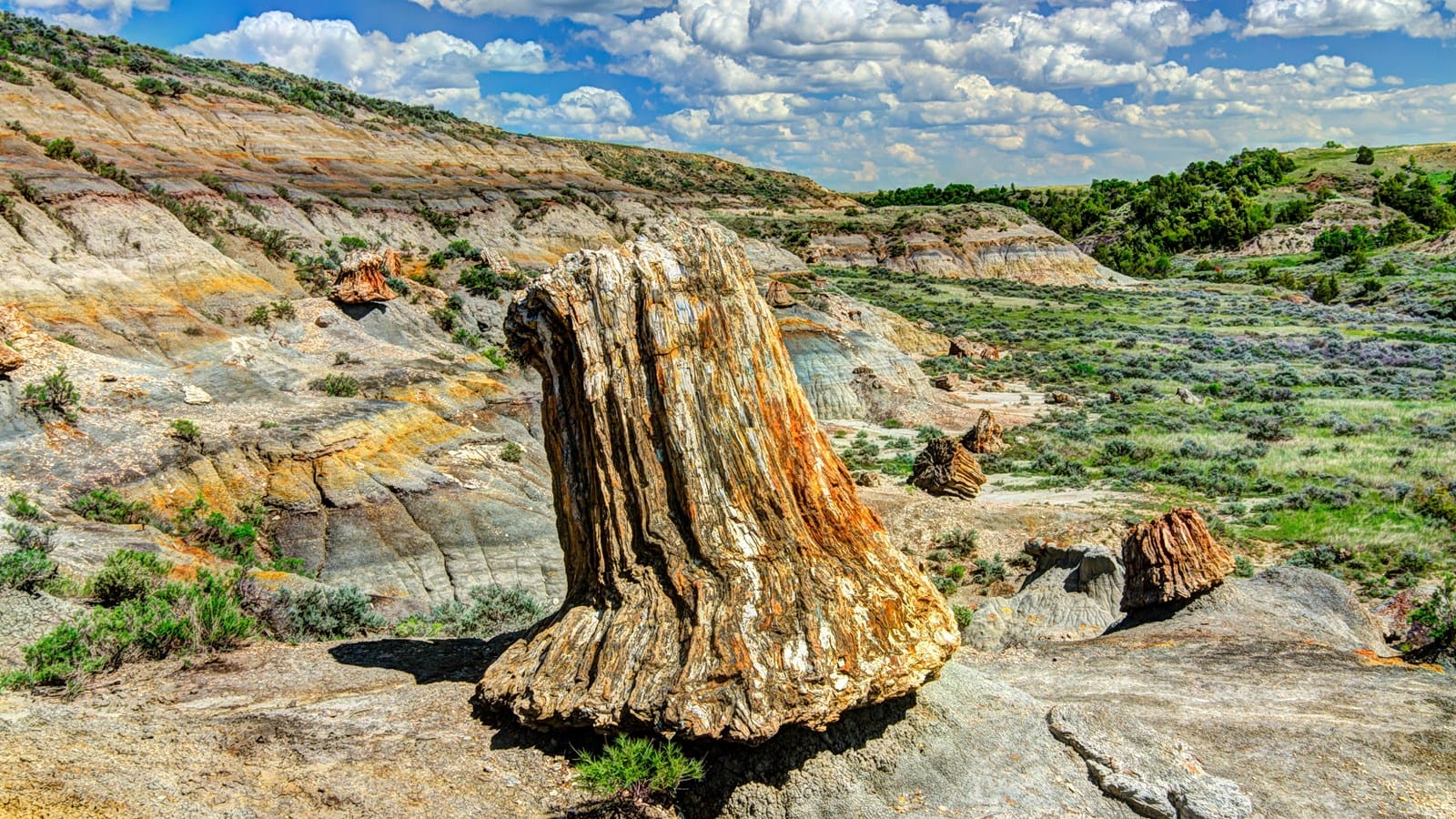Beneath layers of ancient sediment and the weight of millions of years, entire forests—once vibrant with life, rustling leaves, and darting animals—lie silently preserved. These are not the mythical forests of fable or the imaginary groves of fantasy novels. They are real. They once breathed the same air that ancient insects fluttered through, saw the sunlight of a primordial sky, and whispered in winds long lost to history. Today, they remain still and silent, transfigured into stone. We call them fossilized forests.
To encounter a fossilized forest is to touch time. It is to walk through a moment frozen by geology, preserved not in photographs or stories, but in the patient chemistry of the Earth itself. Each fossilized trunk, each petrified stump, tells a tale not only of life that once was, but of death, burial, mineral transformation, and survival across epochs. But what exactly is a fossilized forest? How does something as dynamic and ephemeral as a grove of trees become immortalized in stone?
To answer that, we must travel far back—not just in miles, but in geological ages—through the annals of Earth’s tumultuous past.
From Wood to Stone: The Science of Petrification
The process that turns an ordinary forest into a fossilized one begins not with the living tree, but with its death and burial. When trees die, they usually decompose. Bacteria, fungi, and insects break down wood quickly in moist environments. Within decades, a tree that once towered to the heavens can vanish into mulch and memory. But under the right conditions, this natural decomposition is interrupted.
For fossilization to occur, trees must be rapidly buried. Volcanic ash, sediment from floods, landslides, or even lahar flows (volcanic mudslides) can entomb a forest almost instantly. This sudden burial cuts off oxygen, halting the decay process before it can complete. With time, groundwater rich in dissolved minerals—like silica, calcite, or pyrite—begins to seep through the layers, infiltrating the dead wood.
This is where the alchemy begins.
Over thousands to millions of years, the organic components of the wood—cellulose, lignin, and other molecules—are slowly replaced with these minerals. Silica is the most common agent, and when it fills in the microscopic cellular structures of the tree, it forms quartz. What results is petrified wood: a mineralized mirror of the original organism. Growth rings, bark textures, even cellular details can remain preserved with exquisite clarity.
When this process occurs across an entire ecosystem—a forest, a grove, or even a jungle—the result is a fossilized forest: a stone time capsule of an ancient biosphere.
The Long Story Written in Stone
Each fossilized forest tells a specific chapter in Earth’s book of deep time. Some of the oldest preserved forests date back over 385 million years, to the Devonian Period—the so-called “Age of Fishes,” when land plants were still experimenting with how to grow taller, anchor themselves in soil, and spread across the continents.
These early forests didn’t look much like today’s. There were no flowering plants, no grass, and no birds singing from the branches. Instead, tree-like organisms such as Archaeopteris dominated—fern-like in foliage, with primitive vascular systems and spores rather than seeds. In these fossilized remnants, we find hints of Earth’s first great greening—the moment when land, once barren and lifeless, blossomed into lushness.
In later fossil forests, we find clues to life in the Carboniferous swamps, where giant lycopods and horsetails grew in dense wetlands. These plants—some as tall as modern buildings—would later decay and compress into the coal beds that fueled the Industrial Revolution. And still later, we find Mesozoic fossil forests where conifers, cycads, and gingkoes stood, sharing the land with dinosaurs that walked between their trunks.
In each case, a fossilized forest provides a snapshot of a climate, an ecosystem, a moment when life found a way to thrive—and then a moment when it was abruptly stopped.
Ghosts of the Green World
To walk through a fossilized forest is to experience a haunting blend of the living and the dead. In Petrified Forest National Park in Arizona, for example, visitors stroll past rainbow-hued logs that shimmer with crystalized silica—reds, yellows, purples, and blues, all the product of iron, manganese, and other minerals diffusing through the wood. These trees, members of an extinct conifer species called Araucarioxylon arizonicum, fell during the Late Triassic Period some 225 million years ago.
Back then, Arizona was near the equator, warm and humid, teeming with amphibians, early dinosaurs, and crocodile-like phytosaurs. The trees may have fallen during a flood, washed into a lowland basin, and covered with volcanic sediments. Over millennia, the logs soaked up minerals until they turned to stone.
These logs do not stand upright, but lie scattered—remnants of a forest felled in a cataclysm. Yet in other parts of the world, fossilized forests are still upright. In places like Yellowstone National Park, Alaska, New Zealand, and even Antarctica, vertical stumps remain rooted in place, as if the trees were petrified in mid-growth. These standing fossil forests offer especially compelling insights into the ancient climate and ecology, because they preserve the original positions of growth.
In Antarctica, for example, the fossilized trunks found in the Transantarctic Mountains belonged to forests that grew during the Permian Period, over 260 million years ago—when the icy continent was closer to the equator. These fossil forests bear witness to a radically different past: Antarctica as a temperate forest land, not a frozen desert.
Fossil Clues and Climate Truths
Fossilized forests are more than geological curiosities; they are crucial scientific resources. They offer invaluable data about the Earth’s prehistoric climate, atmospheric composition, and even the rotation of the planet.
By counting growth rings in petrified wood, scientists can infer seasonal changes, drought patterns, and even CO₂ levels in ancient atmospheres. Wider rings indicate rapid growth, likely during warm and wet years. Narrower rings suggest stress—drought, cold, or disease.
Isotopic analyses can reveal the isotopic ratio of oxygen or carbon trapped within the minerals of the petrified wood. These ratios offer clues to temperature, rainfall, and the carbon cycle of ancient times. From such data, paleoclimatologists can piece together models of Earth’s shifting climate across geologic eras.
Fossil forests also shed light on extinction events. In some cases, a sudden layer of ash or sediment indicates a rapid burial—perhaps from a volcanic eruption or meteor impact. Studying such forests can help clarify how ecosystems collapse, adapt, or recover after catastrophic events.
The Role of Time, Pressure, and Silence
Fossilization is not a single moment, but a symphony of processes playing out over incomprehensible time scales. For a forest to fossilize, it must first be buried under enough sediment to prevent decay, then be infiltrated by groundwater carrying the right minerals, and finally be subjected to the immense pressure and temperature of geologic time.
This is a slow alchemy, one that takes thousands to millions of years. It does not obey human clocks. Trees that once reached for the sky are entombed in darkness, where silence reigns and transformation occurs molecule by molecule. Time is the sculptor, and the stone that emerges is its masterpiece.
In this sense, a fossilized forest is not merely dead—it is transformed. It is no longer organic, but neither is it just mineral. It is a hybrid—a memory made tangible.
Cultural Connections and Mythic Resonance
Human beings have long been captivated by fossilized forests. To early civilizations, petrified wood must have seemed like divine relics—wood that turned to stone by some celestial magic. In many cultures, petrified trees were linked with gods, spirits, or omens.
In Native American traditions, some believed the petrified logs of the Southwest were the remains of great battles between sky beings or ancient protectors of the land. In other traditions, petrified wood symbolized endurance, transformation, or a bridge between worlds.
Even today, fossilized forests stir something deep in the human psyche. They remind us that life can outlast its own fragility. That beauty can emerge even in the stillness of death. That our world, with all its modernity, sits atop layers of vanished ecosystems—each one a story worth hearing.
Threats to Ancient Forests
Despite their durability, fossilized forests are not immune to destruction. Looting, vandalism, and careless tourism pose real threats. In places like Petrified Forest National Park, park rangers routinely combat theft of petrified wood by visitors who pocket “souvenirs,” unaware that they are removing scientifically and culturally priceless material.
Moreover, fossilized forests outside protected lands are often exposed to mining operations, urban development, and erosion. Without proper conservation policies, some fossil forests may be lost before they are even studied.
And there is another irony: fossilized forests bear testimony to past climates and extinctions—but they are now threatened by our current climate crisis. Rising temperatures, shifting rainfall patterns, and erosion caused by extreme weather all place stress on exposed fossil sites.
Preserving these ancient woodlands is not just about protecting rocks. It is about safeguarding the memory of Earth’s resilience—and its vulnerability.
A Living Legacy in Stone
While fossilized forests are remnants of the past, they also speak to the future. They are records of how life adapts, how ecosystems evolve, how landscapes recover from devastation. In an age of ecological uncertainty, these ancient stone forests remind us of Earth’s deep cycles.
But they also warn us.
Some fossil forests end abruptly—buried beneath volcanic ash or tsunami deposits, their story stopped mid-sentence. These are not slow extinctions; they are sudden endings. Studying them allows us to understand how quickly life can be erased, and how delicate even vast forests can be.
At the same time, fossil forests reflect the endurance of life. Trees that grew hundreds of millions of years ago, in climates we can scarcely imagine, still stand—preserved in quartz and time. In their silence, they endure. In their petrification, they speak.
And perhaps, as we walk among them, we listen—not just to the past, but to the lessons it still whispers.
Conclusion: Forests Beyond Time
What is a fossilized forest?
It is a paradox: a forest that no longer lives, yet is not dead. A place where time has stopped, but memory continues. A witness to worlds lost and climates changed, yet a guide to understanding our own.
In its mineral silence, it says what no living forest can: that life is ancient, that the Earth is dynamic, and that even in death, something beautiful can remain.
To walk among a fossilized forest is not to visit a museum. It is to enter a cathedral of time.
It is to remember that beneath our feet, deep in the bones of the Earth, lie stories older than any nation, deeper than any myth. And if we pause to listen, they might still have something to teach us—not only about where we come from, but about where we are going.






